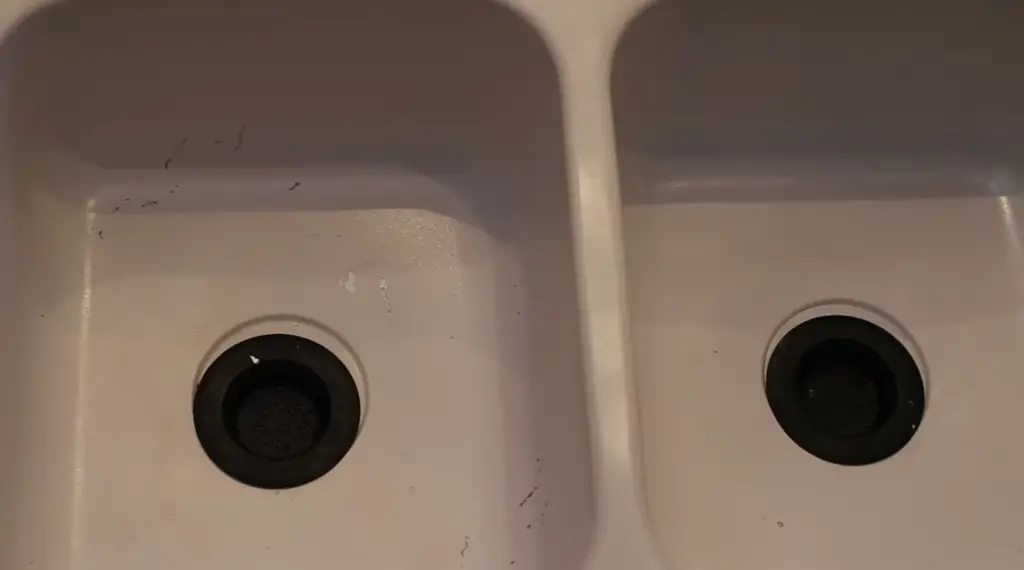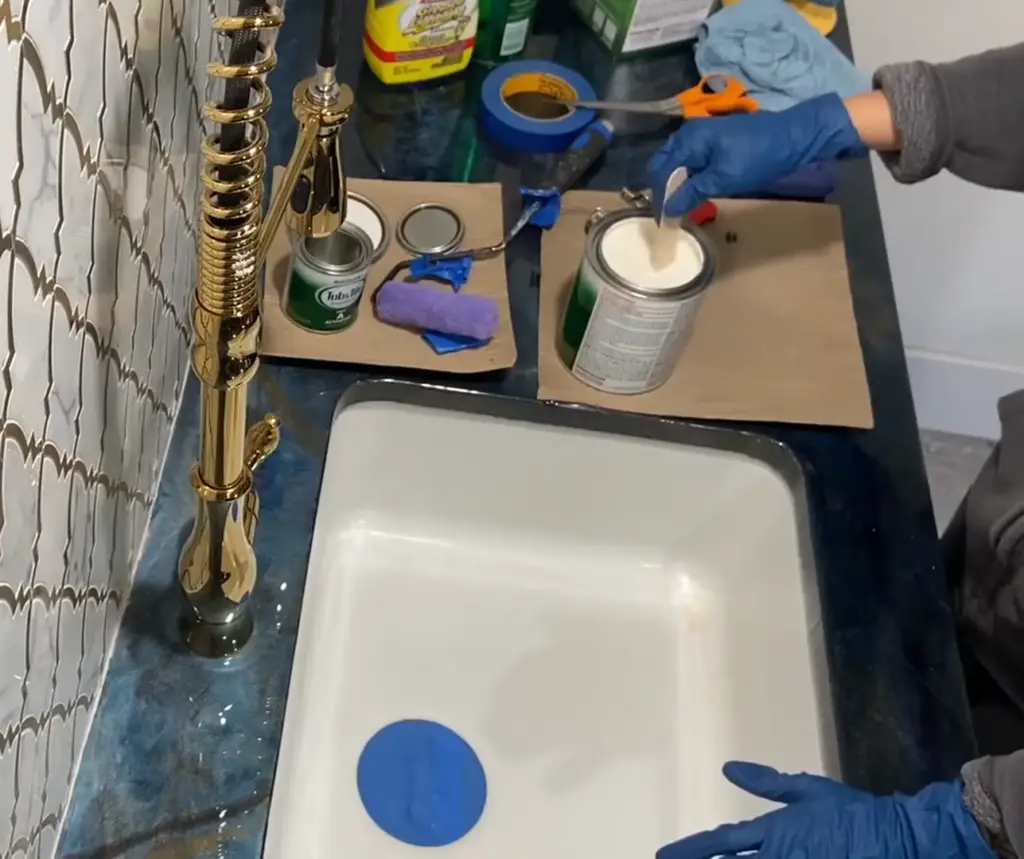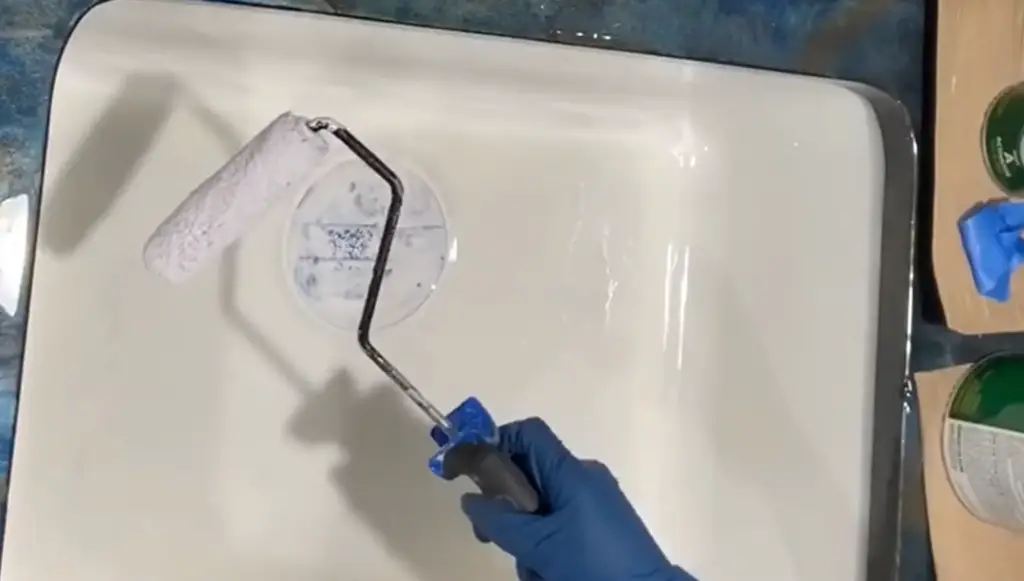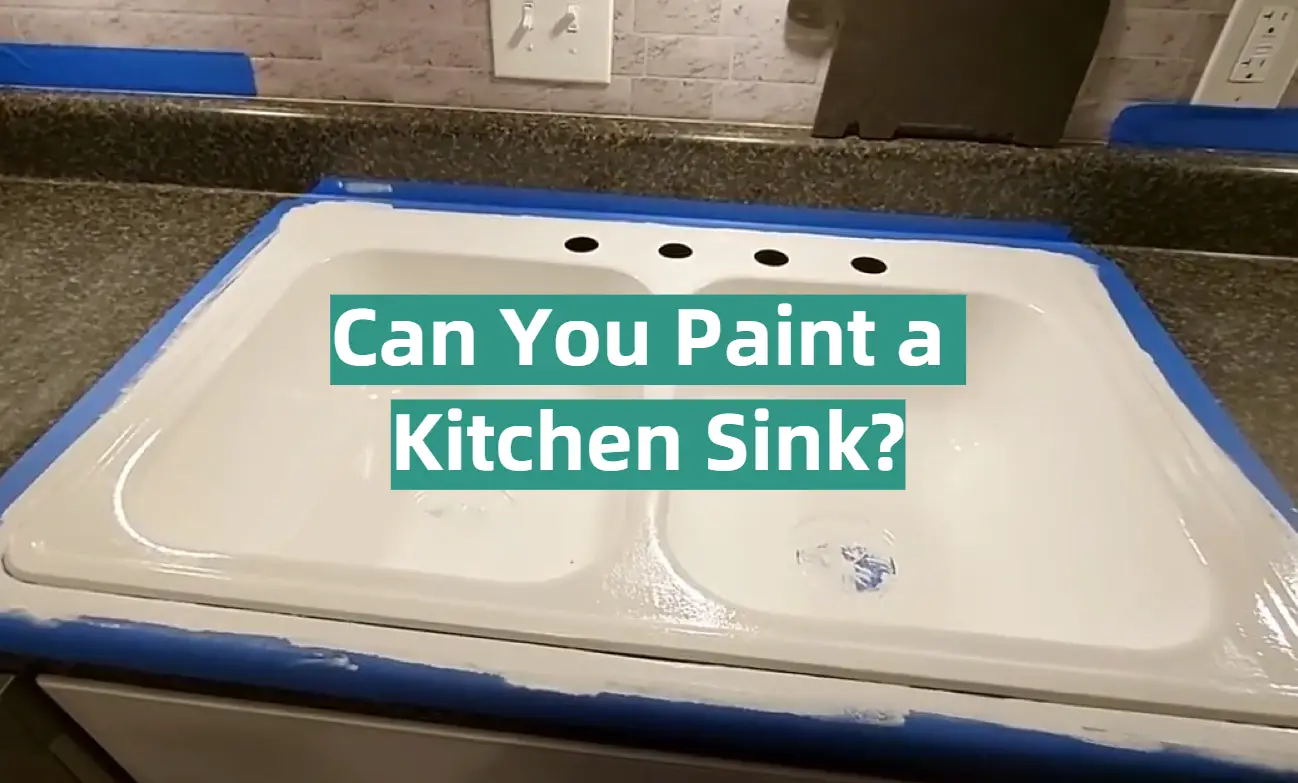If you’re into home improvement, you might have come across the question “Can you paint a kitchen sink?” The answer is yes, but there are certain things that you need to keep in mind before you start painting. This article will provide you with all the essential information you need to know about painting your kitchen sink, such as the types of paint suitable for the job and how to prepare the surface. Additionally, we’ll share some tips to make the process go more smoothly.
Brief Summary
Painting a kitchen sink is possible with the right supplies and technique. The key is using a durable acrylic- or epoxy-based enamel paint made specifically for metal sinks. Thorough cleaning and scuffing provides proper surface prep. Apply a sink-safe primer first, then 2-3 coats of paint, allowing thorough drying between layers. The inside of sinks takes longer to cure. Finish with a protective sealant. On old sinks, remove rust spots and degrease before priming. Porcelain sinks need mild sanding to help paint adhere. Ceramic sinks require the glaze to be scuffed for paint grip. Always check if special primers are needed for your sink material. Proper ventilation, gloves, and masks are essential for safety when painting. Condensation and exterior leaks can cause moisture, so insulation and integrity checks help. With meticulous preparation using the right paints and tools, kitchen sinks can be painted to refresh their look inexpensively. But patience is required for completion and curing before the sink can be used again. Addressing risks and following best practices leads to a smooth paint job that revitalizes the sink.
What Kind of Paint Do You Use on a Sink?
When painting, be sure to use multiple thin coats, allowing each layer to dry fully in between applications. Don’t forget that the inside of a sink will take longer to dry than the outside; give yourself plenty of time to ensure that the paint is completely dry before using.
Finally, don’t forget about the finish! Finish off your sink with a sealant for extra water resistance and shine. Sealants can also help protect against fading, so it’s worth investing in a quality product. A few layers of sealant will keep your sink looking great for years to come. [1]

With just a little bit of preparation and the right supplies, you can easily paint your kitchen sink. Just remember: use the right kind of paint, give it plenty of time to dry, and finish off with a sealant for extra protection.
Can You Paint On an Old Kitchen Sink?
If you have an old kitchen sink that is looking a bit worn and dingy, you may be wondering if it’s possible to paint it. The good news is yes, painting your kitchen sink is definitely an option!
The process of painting a kitchen sink requires some special considerations. Ensure the surface of your sink is clean and free of any grease, soap residue, and dirt. Then, you’ll want to use a degreaser to get rid of any remaining oil or grime on the surface.
Once that’s done, you can apply a primer specifically designed for metal surfaces. This will help ensure the paint adheres properly and prevents any chipping or peeling.
Start by applying two coats of primer and letting them dry. Then, use a foam roller or brush to apply the epoxy paint in even strokes with light pressure. Allow each coat to dry completely between applications until you have three layers of evenly applied enamel paint covering the entire surface.
Once the paint has dried, you can use a sealant to protect your work and give it a glossy finish. Keep in mind that painting your kitchen sink isn’t an easy job, but if done correctly, it can give your sink a fresh new look! So if you’re looking for a cost-effective way to spruce up your kitchen, consider giving your old sink a new coat of paint.

How to Paint a Kitchen Sink
Painting a kitchen sink is not as difficult as it may seem. In fact, with the right tools and materials, you can give your kitchen sink a brand-new look in no time. Here’s how:
- Prepare the surface of the sink for painting. Start by cleaning the entire area with soap and water to remove any dirt or grease residue. Once dry, use sandpaper or steel wool to rough up the surface and get it ready for paint adhesion;
- Choose an appropriate paint for your painting job. Be sure to select a rust-resistant paint that’s designed specifically for sinks and faucets, such as enamel or epoxy paint;
- Apply several coats of paint. Start with a light base coat and then apply two or three additional coats to build up the color and coverage;
- Let the sink dry completely between each coat of paint. This will help ensure that your finished product looks its best;
- Once you’ve completed all of your painting, it’s time to finish off the job with some clear sealer. This will protect the paint from wear and tear and help keep it looking nice for years to come [3];
Painting a kitchen sink is an easy way to update its look without having to replace it entirely. With these helpful tips, you can give your sink a fresh new look in no time!
How to Paint a Porcelain Kitchen Sink
If you’re looking to give your kitchen sink a fresh look, painting it might be the way to go. Painting a porcelain kitchen sink is an easy process that can spruce up your space for relatively little money and effort. Here’s how you can do it:
- Prepare the Sink: Start by cleaning off any dirt or grime on the surface of your sink using soap and water. Once clean, use sandpaper to lightly scuff the exterior of your sink – this will help the paint adhere better when you start painting;
- Prime Your Sink: Now that the surface has been prepared, apply a layer of primer with a paintbrush or roller over your entire sink (including the drain). Be sure to apply a thick, even coat and let it dry;
- Paint the Sink: Mix your chosen paint color with good-quality latex paint in a small bucket. Apply the paint evenly over your entire sink, including the drain area, using either a brush or roller. Make sure you work slowly for an even finish! Once dry, add another coat of paint if needed, then let it cure for at least 24 hours before adding any water to your sink;
- Protect Your Sink: To protect your newly painted sink from chips and scratches, consider applying a layer of clear sealer after the final coat of paint has dried completely. This will help prolong the life of your paint job and keep it looking brand new for years to come;
And that’s it! With these simple steps, you can give your kitchen sink a brand-new look without spending a fortune. Best of luck with your project – happy painting!
Is it safe to paint a kitchen sink?
Painting a kitchen sink can certainly be done, but it is important to understand the risks associated with painting this type of surface. It is not recommended to use any type of oil- or solvent-based paints on the surface as these may cause corrosion and damage the surface over time. Additionally, some products may contain toxins that could be hazardous if inhaled or ingested. To ensure safety, it is best to use water-based latex paint.
It is also worth noting that certain metals may need special primers before painting in order to protect against rusting and peeling over time. If you are unsure about what kind of primer you should use for your particular sink material, consult an expert who can provide guidance.
Finally, be sure to take adequate safety precautions when painting your sink by wearing gloves, goggles, and a dust mask to protect yourself from hazardous fumes. Additionally, ensure that the room is well-ventilated so you can breathe easily while you work. [4]

Type of paint to use to paint a sink
There are a few different types of paint you can use. For porcelain and enamel sinks, oil-based paints are the best option as they adhere better than water-based paints. For stainless steel or chrome sinks, acrylic latex enamel is ideal for painting over them. If you’re unsure about which type of paint to use for your sink, always consult a professional before beginning any project — your local hardware store should be able to help you out with this.
Before starting the painting process, make sure that your sink is thoroughly clean and dry so that the paint adheres properly. Using sandpaper or steel wool on the surface will help create a good base for the paint and will ensure that it lasts longer.
Once you’ve purchased the right type of paint, it’s time to start painting. Use a brush or roller to apply the paint in thin coats and allow each coat to dry completely before applying the next one. Depending on how many coats you decide to use, this part of the process can take anywhere from several hours to an entire day. Once you’ve finished with all your coats, let them dry.
Precautions when Painting a Sink
If you decide to paint your kitchen sink, there are some precautions that you should take before beginning the process:
- First, ensure that the surface of the sink is clean and free from any dirt. Additionally, check for any rust spots or other imperfections in the metal. If there are any rust spots or signs of corrosion on the sink, use a wire brush to scrape them off before applying any paint. After that, apply a primer to ensure even coverage and good adhesion when painting;
- Next, wear protective gloves and clothing when working with materials like spray paints or solvents as they can be dangerous if inhaled or touched directly. Make sure you cover up all nearby surfaces so as not to damage them with any paint splatter;
- Finally, always make sure that you have good ventilation in the area while painting. This is important to avoid inhaling any fumes or chemicals from the paints and primers used in the process. Use a facemask if necessary, and open windows and doors if available;
FAQ
What kind of paint do you use on a sink?
Most people opt for water-resistant enamel paint to apply to the sink. This type of paint is designed specifically to keep moisture out and prevent any chipping or peeling of the finish. It’s important to note that you should never use regular latex paint, which isn’t designed for this kind of environment. Also, special paints are available just for sinks that include mildewcides and fungicides to protect against mold and bacteria growth.
Can you paint a stainless steel kitchen sink?
Yes, you absolutely can! It may take some extra effort to get the job done right but with the right materials and preparation, you can make your kitchen sink look like new.
To start, you’ll need to thoroughly clean and prep your sink for painting. This will ensure that the paint adheres better and lasts longer. Cleaning involves using an appropriate cleaner or solvent to eliminate any dirt and grease from the surface of your sink. Once the surface is fully cleaned, lightly sand it down with some fine-grit sandpaper so that it’s perfectly smooth before painting.

Once your sink is prepped, you can move on to choosing the right paint. Oil-based enamel paints are recommended for painting stainless steel kitchen sinks as they provide a protective layer that keeps the sink looking new for longer. Read the instructions carefully before beginning and be sure to mix your paint properly. [5]
Finally, after your last coat of paint is fully dry, you’ll need to seal it with a topcoat or lacquer sealer to keep it looking its best. This will help protect the paint and prevent chipping or fading over time.
Can you paint porcelain kitchen sinks?
Yes, you can! As long as you take the proper precautions and use the right materials, a painted sink can look just as nice as a brand-new one.
Here’s what you need to know about painting porcelain kitchen sinks: [6]
- Surface Preparation – Before applying any paint, it’s important to thoroughly clean and prepare your sink surface. This will help ensure that your new paint job sticks and looks great. Clean the area with soap and water then lightly sand away any rust spots or dirt particles;
- Primer – Once your surface is prepared, apply an oil-based primer made specifically for porcelain surfaces. Apply two thin coats of the primer using a small brush, roller, or sprayer. Let the primer dry before going on to the next step;
- Paint – After the primer has dried, it’s time to apply your paint! Choose a color that coordinates with your other kitchen decor and use high-quality latex paint. Apply two coats of paint with a brush or roller and let each coat dry before adding another layer;
- Finishing Touches – Once you’ve applied the two coats of paint, you can add some decorative touches if desired! For example, use a stencil to create an interesting pattern or consider adding decals for extra flair. You could also try applying the glaze over the top for a glossy finish — just make sure to let your paint cure for a few weeks before adding the glaze or decals;
And that’s it! With these steps and supplies, you’re ready to give your kitchen sink an upgrade. Painting porcelain kitchen sinks is a great way to breathe new life into an old fixture. So get creative and enjoy the process — happy painting!
Can you paint a ceramic kitchen sink?
Yes, you can paint a ceramic kitchen sink! Painting a ceramic kitchen sink is an easy DIY project that requires minimal preparation and materials. Here are some tips on how to get started:

- Start by thoroughly cleaning the sink with mild soap, hot water, and a soft cloth. Take extra care to remove all dirt and debris from the surface of the sink;
- Once your sink is clean and dry, use sandpaper or steel wool to lightly sand any areas that are rough or sticky; this will ensure better adhesion of the paint;
- Next, apply a layer of primer designed for use on porcelain or enamel surfaces over the entire sink area with a brush. Allow the primer to dry;
- Now it’s time to select a quality enamel paint that is resistant to fading and wear over time, such as a two-part epoxy paint kit. Apply several thin coats of paint with a brush, allowing each coat to dry in between applications;
- After your final coat has dried, apply 2-3 coats of clear sealer for added protection against water and other elements. Allow each coat of sealer to dry thoroughly before using the sink again [7];
With these tips in mind, you’ll be able to paint your sink with confidence.
Conclusion
Overall, painting a kitchen sink is definitely possible and can give you the unique look you desire for your space. It requires patience and diligence to ensure that you are taking all of the necessary steps for success. By using a rust-proof epoxy primer as a base coat, sanding in between coats, and sealing with an appropriate sealant, it’s easy to achieve a professional-looking finish without too much effort.
Now that you have a few tips on painting the kitchen sink from our guide, why not take the plunge? With just a bit of time and effort, you’ll be ready to show off your newly painted kitchen sink in no time! Good luck!
References:
- https://thehoneycombhome.com/transform-your-bathroom-with-sink-paint/
- https://www.hunker.com/12200331/how-to-paint-a-kitchen-sink
- https://hometuff.com/sinks/paint-kitchen-sink/
- https://upgradedhome.com/can-you-paint-a-kitchen-sink/
- https://www.annieandoak.com/blogs/design-style/can-you-paint-a-stainless-steel-sink
- https://homeguides.sfgate.com/paint-porcelain-sink-20898.html
- https://homeguides.sfgate.com/refinish-ceramic-sink-25176.html














As someone who just remodeled my kitchen, I spent a lot of time researching whether I could paint my old porcelain sink instead of replacing it. Most sources said you can paint a porcelain kitchen sink, but you need to use a high-quality enamel paint made specifically for porcelain. I found specific sink paint at my local hardware store and it worked well. Just be sure to thoroughly clean, sand, and prime the sink first. It took a few coats to get good coverage over the old color, but the final result looked amazing! Painting the sink saved me at least $300 compared to replacing it.
When my white ceramic kitchen sink started to show stains and discoloration, I looked into options for painting it instead of buying a whole new sink. I was pleasantly surprised to find many sources confirm you can paint a kitchen sink, whether it’s porcelain, ceramic, or other materials. Careful prep work like sanding and priming is key, then using a durable sink enamel paint. It took me a full weekend but was worth the effort. My sink looks brand new and I saved a ton of money. The paint has held up nicely to daily use and sink chemicals too.
For my recent kitchen remodel, I debated between buying a new sink or trying to paint my existing porcelain one. After research, I decided to paint because many sources said porcelain can be painted with the right products. I cleaned the sink thoroughly with ammonia, lightly sanded, and primed before using a enamel paint made for sinks. I was impressed with how well the paint adhered and transformed the old sink. It has held up perfectly to heavy use. Painting the sink only cost me $30 instead of $250 for a new one!
When we moved into our new place, the white ceramic kitchen sink was really dated and stained. I looked into painting it instead of replacing it. The consensus online was that ceramic sinks can be painted using specific preparatory steps and paint. I scuffed up the glaze with sandpaper, cleaned it, and applied a bonding primer before painting with a few coats of enamel sink paint. It was a time-consuming process but in the end looked amazing, like a brand new custom colored sink! Painting saved me at least $200.
After years of use, my porcelain kitchen sink was badly stained and marked up. I researched painting options instead of replacing the sink. Everything I read said you can successfully paint a porcelain sink as long as you thoroughly clean, lightly sand, and prime the sink beforehand, then apply thin even coats of enamel or epoxy paint formulated for sinks. I followed those steps and am so pleased with how my sink turned out – it looks brand new! Painting porcelain worked perfectly and was much cheaper than a full sink replacement.
When we remodeled the kitchen last year, I decided to try painting the old ceramic sink instead of replacing it. I was able to find specialty epoxy paint made specifically for ceramic sinks at my local hardware store. After cleaning and lightly sanding the sink, I applied several thin coats of the epoxy paint. Though it required careful prep and patience during painting, the end result was amazing – my old sink looked brand new with a durable, custom finish! Painting a ceramic sink is very doable.
Our outdated kitchen had an old stained porcelain sink – I looked into painting it instead of a full replacement. Everything I read said you can paint porcelain sinks with the proper prep and paint. I used scuffing pads and sandpaper to rough up the glazed sink, cleaned it, applied a bonding primer, and then used thin coats of enamel sink paint. It took some time but the results were amazing! The sink looks completely new and modern now. Painting porcelain was the perfect budget-friendly solution.
When our porcelain kitchen sink developed stains, I explored DIY paint options before replacing it. After research, I learned you can paint sinks with proper prep and using durable epoxy or enamel paint formulated for sinks. I sanded the sink lightly to rough up the surface, cleaned thoroughly, applied a bonding primer, and painted with thin even coats of enamel sink paint. Though painting porcelain takes patience, our sink now looks absolutely brand new for way less than a replacement!
We wanted to update our boring white ceramic kitchen sink without the high cost of a new sink. I looked into painting it and found that ceramic can be painted by properly prepping, priming, and using thin coats of specialty epoxy or enamel sink paint. It required careful surface preparation and several paint coats, but the end result was amazing! Our old ceramic sink looks completely new and custom colored now. Painting was a super affordable option.
When our white porcelain kitchen sink began to stain and discolor with age, I looked for an inexpensive makeover option. Everything I read indicated you can paint a porcelain sink as long as you thoroughly prepare the surface with cleaning and light sanding, properly prime, and use thin coats of durable epoxy or enamel paint made for sinks. It took time but was absolutely worth it – our sink looks incredibly modern and new now! Painting porcelain was a very budget-friendly solution.
Our kitchen remodel left us with an outdated porcelain sink – replacing it was cost prohibitive so I explored DIY paint options. After prep by cleaning and scuffing the surface, using a bonding primer, and applying several thin coats of enamel sink paint, our old sink was wonderfully transformed! The paint has held up great to heavy use. While painting a porcelain sink takes patience and care, it produces fantastic results on a budget. I’m so glad I didn’t have to replace our sink.
When we wanted to update our kitchen’s plain white ceramic sink without replacing it, I looked into painting it. I learned you can paint ceramic sinks to renew them using proper products. After thorough cleaning, light sanding, priming, and applying epoxy paint in thin even coats, our old sink looks brand new! The paint has held up wonderfully to daily use. Painting the sink saved us at least $150. While it takes some time and care, painting a ceramic sink successfully is very doable.